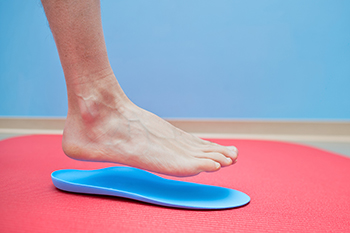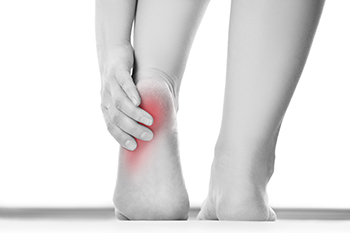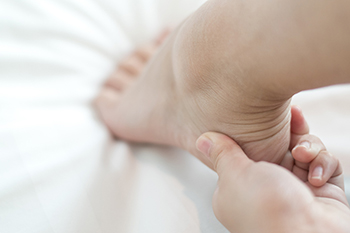

Orthotics are defined as devices that are inserted in the shoes designed to help to correct foot abnormalities. Custom-made orthotics are tailored to a patient's specific needs, and can be effective in providing comfort as daily activities are completed. People who have flat feet or high arches may be candidates for orthotics, in addition to patients who have hammertoe or bunions. Orthotics can alter the angles of how the foot strikes the ground or absorbs shock, and may help to improve balance. Podiatrists may consider orthotics to be a viable option in correcting foot and ankle conditions before considering foot surgery. It is important for people who are diabetic to ensure their orthotics fit perfectly, possibly helping to prevent additional unwanted foot issues. If you would like to know if wearing orthotics is an option for you, it is suggested that you consult with a podiatrist who can guide you toward making the right decision.
If you are having discomfort in your feet and would like to try orthotics, contact Massimo Pietrantoni, DPM from Rochester Podiatry, LLP. Our doctor can provide the care you need to keep you pain-free and on your feet.
What Are Orthotics?
Orthotics are inserts you can place into your shoes to help with a variety of foot problems such as flat feet or foot pain. Orthotics provide relief and comfort for minor foot and heel pain but can’t correct serious biomechanical problems in your feet.
Over-the-Counter Inserts
Orthotics come in a wide variety of over-the-counter inserts that are used to treat foot pain, heel pain, and minor problems. For example, arch supports can be inserted into your shoes to help correct overarched or flat feet, while gel insoles are often used because they provide comfort and relief from foot and heel pain by alleviating pressure.
Prescription Orthotics
If over-the-counter inserts don’t work for you or if you have a more severe foot concern, it is possible to have your podiatrist prescribe custom orthotics. These high-quality inserts are designed to treat problems such as abnormal motion, plantar fasciitis, and severe forms of heel pain. They can even be used to help patients suffering from diabetes by treating foot ulcers and painful calluses and are usually molded to your feet individually, which allows them to provide full support and comfort.
If you are experiencing minor to severe foot or heel pain, it’s recommended to speak with your podiatrist about the possibilities of using orthotics. A podiatrist can determine which type of orthotic is right for you and allow you to take the first steps towards being pain-free.
If you have any questions please contact one of our offices located in Brighton and Greece of Rochester, NY . We offer the newest diagnostic and treatment technologies for all your foot and ankle needs.

During a woman’s pregnancy, she might notice that her feet fall asleep frequently. In other words, she might notice that her feet often experience numbness or a pins-and-needles feeling. This is actually not an uncommon symptom that results from pregnancy. In fact, many women can experience this feeling in the feet at night or immediately upon waking in the morning. The reason why pregnancy can cause numbness in the feet is due to the fact that pregnancy can lead to nerve compression in this area. If you are someone that is pregnant or planning to be, it is suggested that you contact a podiatrist today. This foot specialist will be able to help the pregnant woman navigate feelings of numbness in the feet.
Pregnant women with swollen feet can be treated with a variety of different methods that are readily available. For more information about other cures for swollen feet during pregnancy, consult with Massimo Pietrantoni, DPM from Rochester Podiatry, LLP. Our doctor will attend to all of your foot and ankle needs.
What Foot Problems Can Arise During Pregnancy?
One problem that can occur is overpronation, which occurs when the arch of the foot flattens and tends to roll inward. This can cause pain and discomfort in your heels while you’re walking or even just standing up, trying to support your baby.
Another problem is edema, or swelling in the extremities. This often affects the feet during pregnancy but tends to occur in the later stages.
How Can I Keep My Feet Healthy During Pregnancy?
If you have any questions please feel free to contact one of our offices located in Brighton and Greece of Rochester, NY . We offer the newest diagnostic and treatment technologies for all your foot and ankle needs.

A common cause of heel pain is a foot condition known as plantar fasciitis. This condition affects the plantar fascia, which is the band of tissue connecting the heel to the toes. Plantar fasciitis can cause debilitating heel pain and may gradually worsen until medical attention is received. Intense heel pain can also be a result of Achilles tendinopathy, which is a heel and lower calf injury that happens from overuse. Some people who have peripheral neuropathy have a tingling or numbing sensation in their heel that can be uncomfortable. Rheumatoid arthritis can cause the cartilage to tear in the heel and surrounding area and may cause inflammation, stiffness, and reduced range of motion. If you are experiencing heel pain for any reason, it is strongly suggested that you speak with a podiatrist who can determine what the cause is and offer the correct treatment solutions.
Many people suffer from bouts of heel pain. For more information, contact Massimo Pietrantoni, DPM of Rochester Podiatry, LLP. Our doctor can provide the care you need to keep you pain-free and on your feet.
Causes of Heel Pain
Heel pain is often associated with plantar fasciitis. The plantar fascia is a band of tissues that extends along the bottom of the foot. A rip or tear in this ligament can cause inflammation of the tissue.
Achilles tendonitis is another cause of heel pain. Inflammation of the Achilles tendon will cause pain from fractures and muscle tearing. Lack of flexibility is also another symptom.
Heel spurs are another cause of pain. When the tissues of the plantar fascia undergo a great deal of stress, it can lead to ligament separation from the heel bone, causing heel spurs.
Why Might Heel Pain Occur?
Treatments
Heel pain should be treated as soon as possible for immediate results. Keeping your feet in a stress-free environment will help. If you suffer from Achilles tendonitis or plantar fasciitis, applying ice will reduce the swelling. Stretching before an exercise like running will help the muscles. Using all these tips will help make heel pain a condition of the past.
If you have any questions please contact one of our offices located in Brighton and Greece of Rochester, NY . We offer the newest diagnostic and treatment technologies for all your foot and ankle needs.

Heel pain can be common in children and young teenagers who frequently participate in running and jumping activities. It may indicate Sever’s disease, which is an inflammation of the growth plate in the heel. Sever's disease occurs due to overuse and increased body weight, and it generally happens in the early teenage years during a growth spurt. Parents may notice their child is limping or walking on their tiptoes, and the pain may be worse in the morning. A diagnosis consists of having a physical examination performed, and treatment can begin by learning how to manage the symptoms. It is beneficial to stop the activity that caused the condition. Some relief may be found when the foot is frequently elevated. There are specific stretches that can be performed to strengthen the affected foot. If your active child has heel pain, it is strongly suggested that a podiatrist is contacted who can diagnose and treat Sever’s disease.
Sever's disease often occurs in children and teens. If your child is experiencing foot or ankle pain, see Massimo Pietrantoni, DPM from Rochester Podiatry, LLP. Our doctor can treat your child’s foot and ankle needs.
Sever’s Disease
Sever’s disease is also known as calcaneal apophysitis, which is a medical condition that causes heel pain I none or both feet. The disease is known to affect children between the ages of 8 and 14.
Sever’s disease occurs when part of the child’s heel known as the growth plate (calcaneal epiphysis) is attached to the Achilles tendon. This area can suffer injury when the muscles and tendons of the growing foot do not keep pace with bone growth. Therefore, the constant pain which one experiences at the back of the heel will make the child unable to put any weight on the heel. The child is then forced to walk on their toes.
Symptoms
Acute pain – Pain associated with Sever’s disease is usually felt in the heel when the child engages in physical activity such as walking, jumping and or running.
Highly active – Children who are very active are among the most susceptible in experiencing Sever’s disease, because of the stress and tension placed on their feet.
If you have any questions, please feel free to contact one of our offices located in Brighton and Greece of Rochester, NY . We offer the newest diagnostic and treatment technologies for all your foot and ankle injuries.

Spraining an ankle is a common injury that results from overstretching one or more ligaments that helps to hold the ankle joint together. Signs of an ankle sprain are pain, swelling, and bruising. There are three main types of ankle sprains. A grade 1 sprain is the least serious injury. The ligaments are stretched, but not torn, and the joint remains stable. A grade 2 sprain is more severe and painful, and may indicate that more than one ligament has partially torn. This causes the ankle joint to become less stable, and bearing weight is more difficult. With a grade 3 sprain, more than one ligament is torn, and ankle movement is impossible. If you have this type of sprain, seeking immediate medical attention is imperative. Ignoring an ankle sprain can be permanently damaging to the joint. For that reason, if you believe you may have sprained an ankle, it is suggested that you consult a podiatrist for an evaluation and treatment.
Ankle sprains are common but need immediate attention. If you need your feet checked, contact Massimo Pietrantoni, DPM from Rochester Podiatry, LLP. Our doctor can provide the care you need to keep you pain-free and on your feet.
How Does an Ankle Sprain Occur?
Ankle sprains take place when the ligaments in your ankle are torn or stretched beyond their limits. There are multiple ways that the ankle can become injured, including twisting or rolling over onto your ankle, putting undue stress on it, or causing trauma to the ankle itself.
What Are the Symptoms?
Preventing a Sprain
Treatment of a Sprain
Treatment of a sprain depends on the severity. Many times, people are told to rest and remain off their feet completely, while others are given an air cast. If the sprain is very severe, surgery may be required.
If you have suffered an ankle sprain previously, you may want to consider additional support such as a brace and regular exercises to strengthen the ankle.
If you have any questions please feel free to contact one of our offices located in Brighton and Greece of Rochester, NY . We offer the newest diagnostic and treatment technologies for all your foot and ankle needs.